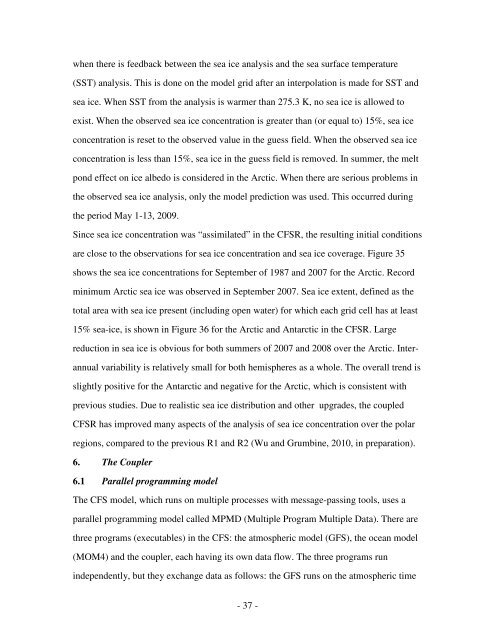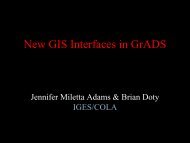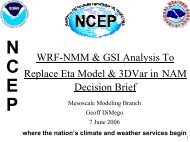<strong>The</strong> passive microwave weather filters are imperfect, meaning that ice concentrations canbe reported from the microwave for reasons other than ice being on the surface, so that asea surface temperature filter is also used [Grumbine, 1996]. <strong>The</strong> sea ice concentrationswere in general produced before the SST analyses used for the CFSR. <strong>The</strong>refore an aposteriori filter was used for retrospective analyses through 29 October 2007 [Grumbine,2009]. <strong>The</strong> usual SST filtering was also done using AVHRR-Only analysis [Reynolds etal., 2007] for 4 January 1985-10 February 2000. <strong>The</strong> RTG low resolution analysis[Thiebaux et al., 2003] was used 11 Feb 2001 through 29 October 2007 and RTG highresolution analysis [Gemmill et al., 2007] thereafter. A more detailed document on theCFSR sea ice analysis is in preparation [Grumbine, 2010b].5.2 <strong>The</strong> Sea Ice Model<strong>The</strong> sea ice model is from GFDL Sea Ice Simulator with slight modifications. Similar tothe ocean model, sea ice model components use a tripolar grid north of 65N, i.e., a gridthat has "poles" located in the land masses of northern Canada and northern Russia, inaddition to the normal South Pole. <strong>The</strong>re are three layers in the sea ice model, includingtwo equal layers of sea ice and one layer of snow with five categories of sea ice thickness(0-0.1, 0.1-0.3, 0.3-0.7,0.7-1.1, and a category greater than 1.1 m). Sea ice dynamics isbased on Hunke and Dukowicz (1997) using the elastic-viscous-plastic technique tocalculate ice internal stress. Ice thermodynamics is based on Winton (2000). It is possiblefor ice to be transferred between the snow layer and the two ice layers, conservatively,when there is snowfall, evaporation, freezing or melting. When sea ice forms over theocean it releases latent heat and salt to the ocean. Details can be found in Griffies et al.(2004).Due to the lack of sea ice observations of thickness and motion covering CFSRperiod starting 1979, a sea ice merging scheme is used in CFSR to add sea iceconcentration into the system. This scheme merges the observed sea ice concentrationwith the coupled 6-hour forecast guess field to produce a new initial condition at eachanalysis cycle. During the merging process, quality control is applied to prevent a failure- 36 -
when there is feedback between the sea ice analysis and the sea surface temperature(SST) analysis. This is done on the model grid after an interpolation is made for SST andsea ice. When SST from the analysis is warmer than 275.3 K, no sea ice is allowed toexist. When the observed sea ice concentration is greater than (or equal to) 15%, sea iceconcentration is reset to the observed value in the guess field. When the observed sea iceconcentration is less than 15%, sea ice in the guess field is removed. In summer, the meltpond effect on ice albedo is considered in the Arctic. When there are serious problems inthe observed sea ice analysis, only the model prediction was used. This occurred duringthe period May 1-13, 2009.Since sea ice concentration was “assimilated” in the CFSR, the resulting initial conditionsare close to the observations for sea ice concentration and sea ice coverage. Figure 35shows the sea ice concentrations for September of 1987 and 2007 for the Arctic. Recordminimum Arctic sea ice was observed in September 2007. Sea ice extent, defined as thetotal area with sea ice present (including open water) for which each grid cell has at least15% sea-ice, is shown in Figure 36 for the Arctic and Antarctic in the CFSR. Largereduction in sea ice is obvious for both summers of 2007 and 2008 over the Arctic. Interannualvariability is relatively small for both hemispheres as a whole. <strong>The</strong> overall trend isslightly positive for the Antarctic and negative for the Arctic, which is consistent withprevious studies. Due to realistic sea ice distribution and other upgrades, the coupledCFSR has improved many aspects of the analysis of sea ice concentration over the polarregions, compared to the previous R1 and R2 (Wu and Grumbine, 2010, in preparation).6. <strong>The</strong> Coupler6.1 Parallel programming model<strong>The</strong> CFS model, which runs on multiple processes with message-passing tools, uses aparallel programming model called MPMD (Multiple Program Multiple Data). <strong>The</strong>re arethree programs (executables) in the CFS: the atmospheric model (GFS), the ocean model(MOM4) and the coupler, each having its own data flow. <strong>The</strong> three programs runindependently, but they exchange data as follows: the GFS runs on the atmospheric time- 37 -
- Page 2 and 3: ABSTRACTThe NCEP Climate Forecast S
- Page 4 and 5: 1. IntroductionThe first reanalysis
- Page 6 and 7: In this paper we only discuss globa
- Page 8 and 9: the reanalysis was halted to addres
- Page 10 and 11: online archive of data for reanalys
- Page 12 and 13: density MESONET data is included in
- Page 14 and 15: The 1B datasets were calibrated usi
- Page 16 and 17: MetOp is Europe's first polar-orbit
- Page 20 and 21: The third GSI feature enabled in th
- Page 22 and 23: the hydrostatic assumption. Soon af
- Page 24 and 25: esolution with 28 sigma layers in t
- Page 26 and 27: SW and LW radiations at one-hour in
- Page 28 and 29: SST data. The other uses AVHRR and
- Page 30 and 31: y Gent and McWilliams (1990; see al
- Page 32 and 33: from the Global Temperature-Salinit
- Page 34 and 35: through the end of the data set in
- Page 39 and 40: from the sea ice/ocean back to the
- Page 41 and 42: weight is assigned to the gauge ana
- Page 43 and 44: Stream 6: 1 Jan 1994 to 31 Mar 1999
- Page 45 and 46: in the mid 1990’s, the period whe
- Page 47: e due to a change over the oceans (
- Page 52 and 53: In Figure 49, we show the temporal
- Page 54 and 55: distributed in time and space. Desp
- Page 56 and 57: forecast model at a lower resolutio
- Page 58 and 59: Appendix A: AcronymsAER Atmospheric
- Page 60 and 61: ONPCMDIPIRATAPROFLRQBOQuikSCATR1R2R
- Page 62 and 63: TMP2M 2m air temperature 24 / 473TM
- Page 64 and 65: Appendix C: The Data AccessTo addre
- Page 66 and 67: Figure 26 shows the global total bi
- Page 68 and 69: Argo Science Team, 2001: The global
- Page 70 and 71: Compo, G.P., J.S. Whitaker, and P.D
- Page 72 and 73: ozone Mapping and Profiler Suite (O
- Page 75 and 76: Global Forecast System. Manuscript
- Page 77 and 78: and climate models. Atmos. Chem. Ph
- Page 79 and 80: performance Earth system modeling w
- Page 81 and 82: with mesoscale numerical weather pr
- Page 83 and 84: experiments using SSM/I wind speed
- Page 85 and 86: Figure 21: Same as Figure 2, but fo
- Page 87 and 88:
Figure 45: The fit of 6-hour foreca
- Page 89 and 90:
Figure 1: Diagram illustrating CFSR
- Page 91 and 92:
Figure 3: Same as in Figure 2, but
- Page 93 and 94:
Figure 5: Same as in Figure 2, but
- Page 95 and 96:
Figure 7: Same as in Figure 2, but
- Page 97 and 98:
Figure 9: Same as in Figure 2, but
- Page 99 and 100:
Figure 11: Same as in Figure 2, but
- Page 101 and 102:
Figure 13: Same as in Figure 2, but
- Page 103 and 104:
Figure 15: Radiance instruments on
- Page 105 and 106:
Figure 17: Same as in Figure 16, bu
- Page 107 and 108:
Figure 19: Global average Tb first
- Page 109 and 110:
Figure 21: Same as in Figure 16, bu
- Page 111:
Figure 23: Comparisons of the SSU b
- Page 114 and 115:
Figure 26: The global total bias fo
- Page 116 and 117:
Figure 28: The yearly total of trop
- Page 118 and 119:
Figure 30: The vertical structure o
- Page 120 and 121:
Figure 32: The global number of tem
- Page 122 and 123:
Figure 34: The same as Figure 33, b
- Page 124 and 125:
Figure 36: Monthly mean Sea ice ext
- Page 126 and 127:
Figure 38: 2-meter volumetric soil
- Page 128 and 129:
Figure 40: Schematic of the executi
- Page 130 and 131:
Figure 42: Yearly averaged Southern
- Page 132 and 133:
Figure 44: Monthly mean hourly surf
- Page 134 and 135:
Figure 46: Global mean temperature
- Page 136 and 137:
Figure 48: Zonal mean total ozone d
- Page 138 and 139:
Figure 50: The subsurface temperatu
- Page 140 and 141:
Figure 52: Vertical profiles of the
- Page 142 and 143:
Figure 54: Zonal surface velocities
- Page 144 and 145:
ProgramPREVENTSACQCACAR_CQCCQCCQCVA
- Page 146:
Satellite Starting date Ending Date





